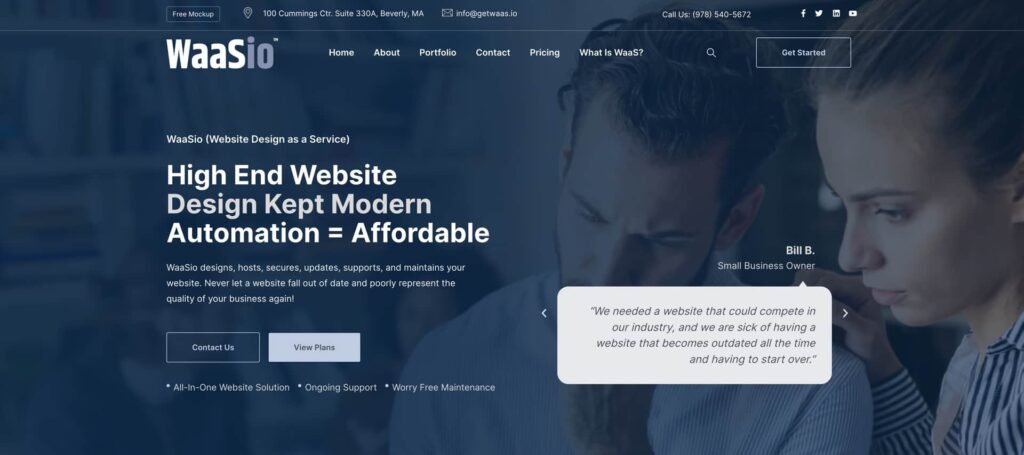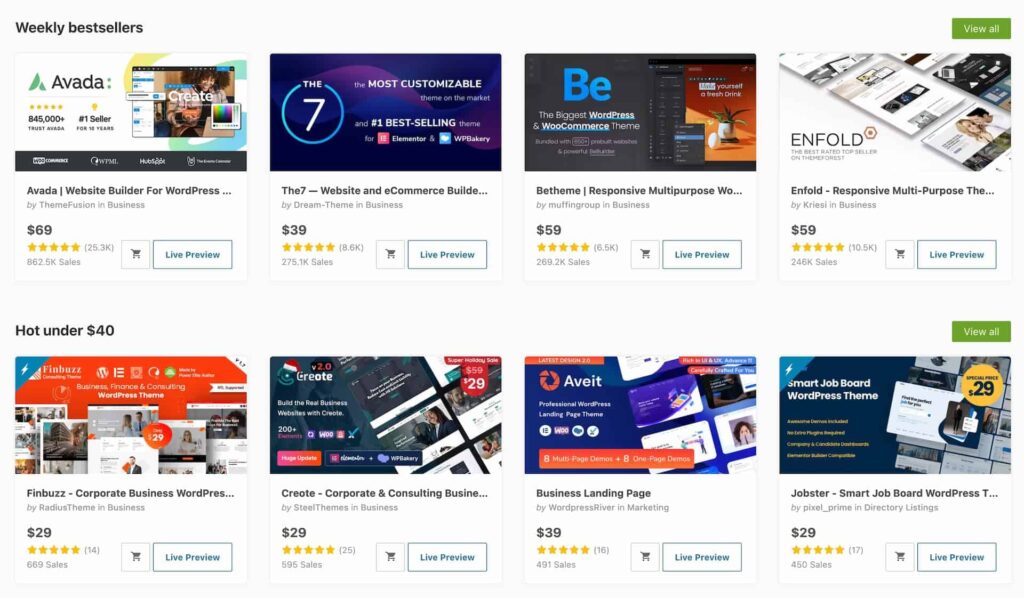I’ve put a lot of thought into all the popular web design pricing models. And I’ve tested many of them in the real world with real prospects over the years, so when I argue against WaaS it comes from a depth of experience, not a cursory glance.
Proponents of WaaS claim that it’s a model beneficial to the agency as well as the client, but the worst parts of WaaS have the opposite effect. So, I hope you’ll see that many of the arguments I make against WaaS are for the client’s benefit, not just the agency’s benefit.
This isn’t to say that there are no benefits to WaaS or that it’s a bad idea in all cases. My basic conclusion is that it’s a bad idea in most cases, and a decent fit in some cases. I don’t think it’s ever the “best” option, but it can undoubtedly be acceptable depending on the circumstances.
We’ll get into all this in detail later. For now, let’s make sure we’re all on the same page.
And I want to make it clear that if you’re a proponent or implementor of WaaS, this isn’t personal. We can still be friends. You haven’t committed some great moral failure. If you disagree with my points and want to provide a respectful, thoughtful rebuttal, I’m more than excited to hear what you have to say!
What is Website as a Service (WaaS)?

Just for fun, and because I didn’t want to find a creative way to write a basic overview of WaaS, I asked Chat GPT, “What is Website as a Service?”
Here’s what it spit out:
Website as a service (WaaS) is a type of service in which a company provides a complete website solution to its customers. This typically includes hosting, design, and maintenance of the website, as well as any additional features or functionality that the customer may require.
WaaS is often used as an alternative to building and maintaining a website in-house, as it allows companies to outsource these tasks to a specialized provider. This can be especially useful for small businesses or organizations that do not have the resources or expertise to manage a website on their own.
Some common features of WaaS include content management systems (CMS) for easy updates and editing, analytics and performance monitoring, and responsive design to ensure that the website looks and functions well on different devices. WaaS providers may also offer additional services such as search engine optimization (SEO), social media integration, and e-commerce support.
ChatGPT
Alas, it could be a better answer.
Yes, all that stuff is accurate, but it should have explained how WaaS differs from traditional web design with a management plan, which is what people want and need to know.
So, back to manual explanations.
In the traditional model, an agency scopes out a website and puts a fixed price on it (usually thousands of dollars). They build it for a fixed price, and then they either hand it over to the client or tack on a monthly management plan that includes maintenance, hosting, content edits, etc.
In the WaaS model, there’s no project scoping. Instead, the agency offers pre-defined subscription plans for a low monthly payment, including the entire website build.
This payment is ongoing forever, even after the website is built, and includes management, maintenance, edits, etc., after the initial build is complete.
The main practical difference between the two models is that the prospect must pay thousands of dollars upfront for their website in the traditional model and only a low monthly payment ($100/mo to 400/mo) in the WaaS model.
Deposits are common in the WaaS model, so the prospect will often need to shell out $500 to $1000 the first month to get the project going, but they only owe the agreed monthly payment after that.
Why the WaaS model is getting so much attention
Here’s why I think the WaaS model is popular and getting so much attention lately:
From the client’s perspective:
It feels far easier and less risky to pay $200/mo forever than $5000 upfront, especially if the business is a startup, solopreneur, etc.
Paying monthly fees for software, cleaning, etc., feels typical to businesses. Their website would be another one of those fees.
WaaS makes the decision more about affordability and less about understanding the full scope of deliverables since it’s presented as “all-inclusive.”
From the agency’s perspective:
The thing you’ll hear WaaS agencies talk about over and over again is recurring revenue. Over time, the WaaS model becomes more and more of an asset to the agency because you get to collect fees on projects you completed a long time ago that no longer take much of your time or energy.
It’s also easier to sell. There’s no need to create a detailed proposal or scope of work, present that to the client, and then have the dreaded discussion about why you’re charging thousands of dollars.
WaaS makes marketing feel more effortless, too. Since your business revenue is consistent due to recurring revenue (in theory), you don’t have to be on the hunt for new projects constantly.
Okay, so let’s recap:
WaaS is easy to sell and buy, helps agencies generate consistent revenue, and the client still gets a new website.
What’s the problem here?
WaaS problem #1: It’s too easy to buy.

Is friction in sales a bad thing?
Nope. Sales friction for non-commodity products and services is desirable. Not just for the buyer but for the seller as well.
A website is essential for a business. And not all websites are created equally. The ROI of a website from Agency A can be 10x that of a website created by Agency B.
When there’s no friction in the sales process, the buyer makes decisions too quickly. There needs to be more time spent on due diligence. They may need help understanding what they’re buying. And they need to find out if what they’re buying aligns with their needs.
Amateur sellers desire a frictionless sale, but any agency worth a damn knows that clients who buy too quickly are often the worst. They aren’t “bought in” to the agency culture, a specific thought process, a proper plan, or anything else that matters.
It’s in the best interest of both parties to put more consideration into things before pulling the trigger.
In an industry where we want clients to choose us based on merit, culture, and game plan, WaaS encourages buyers to decide mainly on the price.
WaaS problem #2: Generic packages, rather than the client’s goals, define the deliverables

In the previous point, I said, “The ROI of a website from Agency A can be 10x that of a website created by Agency B.”
Why? Because some agencies do the necessary work to understand their client’s needs and can devise a game plan to meet those needs.
The fundamental problem of the WaaS model is that it tries to put every client in a predetermined bucket. The price and deliverables are defined before the agency and client ever meet.
WaaS agencies will argue that they can still deliver items outside the predetermined plans. But doesn’t that start to break the model? How many things do you need to offer as “extras” before this is considered a traditional proposal?
There’s plenty of a grey area here, but the point stands. WaaS sounds like: generic packages for generic work for generic clients.
“Objection! Badgering the witness!”
Your Honor, let me continue…
WaaS problem #3: You’re probably getting a templated site

Talk to someone who uses the WaaS model. They’ll be the first to tell you how great it is because “it’s easy to sell and deliver.”
“What makes it easy to deliver?” I ask.
“Well, the client chooses one of our templates that they like, and we just change the colors and insert the content,” they explain.
Different WaaS agencies will use templates to varying degrees, of course, but the staple of WaaS is templating. It has to be. You can’t create a $25,000 custom website for one low monthly payment of $200. It would take 125 months to break even. That’s ten years, which might as well be 100 in web design years.
“What’s wrong with a templated website, Kevin?”
If you run a generic business and need a generic package to cover generic work, then there’s nothing wrong with a templated website.
Our web design agency doesn’t work with generic businesses, so we don’t use templates. And if we do happen across a generic company, we help that business break out of its genericness.
I didn’t go to school for business, but I’m confident that “Be generic!” has never been the recommendation. There are nearly a gazillion business books (I counted) outlining why being unique and exciting is essential. If you need quick references, check out books like Zag, Purple Cow, The 21 Immutable Laws of Marketing, Blue Ocean Strategy, or Building a StoryBrand.
And herein lies the problem with WaaS agencies. They’re more than happy to build you a generic website if you have a generic business. They’re not going to put a consultant hat on and help you build a better business. No, they’ll gladly deliver the mediocrity you ask for and consider that, “winning.”
WaaS problem #4: Can the site adapt and keep up?
Templated websites often have another problem: adaptability.
What your business needs now and what your business may need a year from now are often two different things. The question is, “Can the platform your website is built on support your changing needs?” And the second question is, “Can the agency you’re working with keep up as your business gets more legit?”
When we build custom websites for clients, we use an open-ended platform that doesn’t limit options. Templates, on the other hand, can cause a lot of dead ends.
Remember, WaaS agencies are only profitable if they can keep costs low. And part of keeping costs low often means using tools with significant limitations.
Need custom ordering functionality added to your restaurant website because it’s 2020, there’s this thing called Covid, and nobody is allowed to dine inside?
<ring> <ring>
“We need to change up our website. This Covid thing is killing us. People can’t dine in, so we need them to be able to order everything online for pickup. It’s gotta be an organized system that creates a smooth experience for customers and our staff.”
“Oh, sorry, we built your site with XYZ to save money, so that’s not an option.” Or, “Oh, sorry, we’re not equipped to do custom work like that.”
Or, if custom functionality like this is an option, it’s usually some hacked-together, horrific implementation that everyone hates.
The Covid thing is just one real-world example. But the need for custom work, unique implementations, etc., always pops up, especially when a company tries to shake off the fog of mediocrity and starts to do things differently.
When it comes time to adapt – to box in the ring and fight for titles like a true competitive business – do you want to look over and see the “we do templates” agency in your corner? Or would you rather see the Mickey Goldmill of agencies – someone capable of helping you achieve your biggest goals?
As I said earlier, choosing the wrong agency can have a tremendous cost in terms of lost opportunity.
WaaS problem #5: It creates big cashflow problems in the early stages

Let’s focus more on the downside for agencies now.
In the early stages of business, WaaS severely limits your ability to scale the agency. Where WaaS creates powerful cashflow over time, it initially creates a massive cashflow crisis.
You can’t pay your agency’s bills with $200/mo from a single client. So, how many clients do you need?
If you want $8500 per month in revenue (small beans in the agency world), you need 42.5 clients.
Can you handle 42.5 clients without a team? How big does your team need to be? How fast can you build sites and break the 42.5 client mark? Where are you even going to find 42.5 clients?
If you need a team, how will you pay them? If you make your clients pay a larger deposit before the monthly subscription kicks in, this can help, but once those sites are done and launched, then what?
Building a team for any agency is challenging because it’s more than just finding the right people to work on a single project or batch of projects. You also have to be in a situation where you can feed them consistent work, or they’ll leave.
The only way to pay a team initially with the WaaS model is to keep bringing in many new projects. Why? Because you need the deposit money. The subscription revenue won’t be enough to pay team members until further down the line.
Since you’re building templated sites on fast timelines in the WaaS model, the runway is short, and so is the money.
In the traditional model, closing one project at $20,000 is enough to keep a small team busy for 3-4 months. And a small team can handle 4-5 of those types of projects over the same period. That’s $100k in revenue over 4-5 months, a much healthier and less stressful cashflow situation.
WaaS problem #6: The math is sketchy on a single-project basis
Agency A proposes the WaaS model for a small business website at $200/mo. Agency B suggests a $7500 custom site. It’s a scenario where the client would say “Yes” to either one.
In Scenario A, the WaaS agency also charges a $1000 deposit. That’s more than most WaaS agencies I’ve researched, but I’m giving the benefit of the doubt.
So, Agency A gets $1000 up front and then $200/mo recurring. It takes them 32.5 months to hit the $7500 mark.
Agency B charges $7500 in 3 monthly installments of $2500. It takes 3 months to hit the $7500 mark.
Let’s keep in mind that the average lifespan of a website is three years. After that, a business should consider a redesign.
So, at 32.5 months, which is close to three years, the WaaS agency is approaching “The Transition.” The Transition is the point at which a WaaS project goes from “we collected typical costs” to “we’re making money for doing hardly anything.”
But, their client needs a refresh right as they arrive at The Transition! And Agency B, at this exact point in time, gets to propose another redesign at however many thousands of dollars.
This scenario also exposes the “revenue for project-based work stops when the work stops” myth. It doesn’t, precisely because a website in the modern age is a living, breathing thing. Clients need more work. The website needs to adapt. And every three years, it needs to be completely refreshed.
WaaS agencies might argue, “I would never do a $7500 site, though. We service clients who would never pay that. We do sites for clients who are only willing to pay $1500 or so.”
And yes, at a $1500 price tag, the WaaS model looks much better. $500 for a deposit, $150/mo. Something in that range. In 6.6 months, we arrive at The Transition, making $150/mo more or less free and clear for the next 2.5 years.
However, the problem with this logic is…
WaaS problem #7: WaaS is often a crutch
My general feeling is that most of the WaaS agencies I’ve come across have adopted the WaaS model because they suck at sales. Or because they have some negative feelings toward sales and selling at higher prices.
When an agency sucks at sales, they typically don’t say, “We suck at sales.” Want to know what they say? They say, “The type of clients we work with can’t afford [higher number].”
Granted, this is often because those clients literally say, “We can’t afford [higher number].” But hear me out! Hear me out. Clients lie, too.
When a client says, “We can’t afford X,” it often means, “We’d never pay that in exchange for what you’ve proposed.”
In other words, your proposal sucked.
See, I’ve gone into sales meetings where the client supposedly had a budget of $7500, and I closed them on a $20k site.
They “couldn’t afford” more than $7500, but they made a $20k purchase.
How is this possible? Because in their mind, a website was only worth $7500 max. But, after being educated via the sales process, their understanding of the value of a website to their business changed.
Write this down: Numbers are more relative to the people on either side of a deal than they are to the deliverables themselves.
And remember, paying more is often a benefit to the client! I can only do so much with $7500. Perhaps, with $7500, I cannot implement the essential pieces that turn linear ROI into geometric ROI.
With $20,000, I could implement those pieces that create geometric ROI. And now your business is in a different class.
To get you to understand that to the point that you’re willing to write the check, I have to be good at sales. Not good at swindling you, tricking you, milking you, or any other things people label as “sales.” I’m talking about actual sales – painting a picture, communicating value, answering questions, understanding needs … those sorts of things.
I also have to be comfortable talking about money, one of the most challenging parts of sales. If someone isn’t comfortable talking about money, they inherently dislike sales.
These challenges are why many people opt for the WaaS model. It’s easier to make an insanely low-priced offer and hope the person buys on price alone. Then you’re free to skip all the messy stuff I just talked about, right?
But this couldn’t be more awkward! You are offering generic subscription packages in exchange for generic work that only serves generic companies, not because there’s some benefit to the client but primarily because of your own insecurities.
Nobody wins in that scenario.
WaaS problem #8: WaaS forces you to choose a tight niche
And now we have arrived at the final big problem with WaaS. The fact that it forces you into a tight niche.
Why? It goes back to the fact that WaaS is about templating and keeping things generic. Most WaaS agencies create a few templates that work well for the types of businesses they serve (niche), and they can only afford to work in that lane.
Of course, many business gurus will say that “niching down” is a great strategy. It allows you to focus, streamline your processes, and more easily demonstrate your expertise to prospects within the niche.
These things are all true, of course. A niche focus can be a huge benefit. But it also comes at a high cost – a price that could cripple you, the agency owner.
See, if you’re like me, you’re creative at heart. You love having new and exciting challenges to solve. You like variance in your work. You’d much rather explore new design ideas or build a new unique part of a website than do mundane, routine, factory-style work.
If you don’t feel this way, then WaaS on. If you do feel this way, then pause for a moment.
Suppose you go with WaaS and niche down out of necessity. In that case, you’re enlisting yourself to a lifetime of work in a web design factory where the only thing inspiring about your work is the Mt. Everest of recurring revenue you’re trying to build.
Congratulations, you’re “all about the money” now.
Are you about solving unique business challenges for remarkable clients? Nope! That was too hard to sell, and the numbers felt vawy vawy scawy.
Can you explore a new design trend for this next client? Umm, are you crazy? There’s no money to do that! You’ll be upside down on the project! Pull up the template you’ve used 1000 times before and drop their content in so you can move on.
Can you talk the client into paying extra for some unique features or flare? Probably not! You’ve dedicated your business to attracting low-budget, mediocre clients. Plus, you still suck at sales because you’ve been leaning on this WaaS crutch instead of honing your skills.
At the end of the day, the WaaS model could enable you to win a fantastic recurring revenue game. But, if it’s at the cost of your creative soul, you’ve still lost.
Wrap-Up: Is WaaS ever acceptable?
Given my arguments against WaaS, I still have people asking me if there’s a scenario where it’s acceptable.
I would never offer WaaS as a primary game plan. However, I keep it in my back pocket as an option for specific projects.
What type of projects, you ask?
I keep it as a generic offer for generic clients who want generic work.
Seriously.
Sometimes my sales skills fail, and I cannot convince a client to make the right decision. But I still like this client, and I’m confident I can help them escape mediocrity over time. So, I need to give them what they want in the short term and work to give them what they need in the long term.
I make them the WaaS offer, create a generic site, earn more trust, and then get back to convincing. That’s only if I like them, though.

